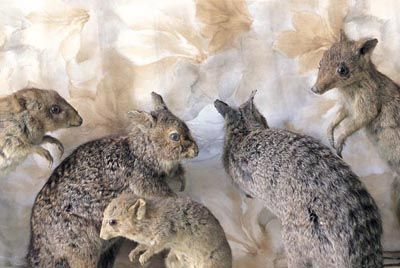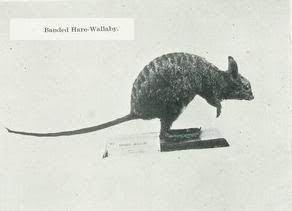|
|
Post by Melanie on Sept 12, 2007 15:16:32 GMT
BANDED HARE-WALLABY Lagostrophus fasciatus ssp. albipilis The banded hare-wallaby was endemic to mainland Australia. It has not been recorded since 1906. The disappearance of this species may have been associated with the clearance of vegetation for agriculture, competition for food with rabbits and livestock, and predation from foxes. |
|
|
|
Post by Melanie on Sept 12, 2007 15:18:52 GMT
Note: Lagostrophus fasciatus ssp. albipilis is only an invalid subspecies! The true Banded Hare-Wallaby Lagostrophus fasciatus still survives on two islands in the Shark Bay.
|
|
|
|
Post by Melanie on Sept 12, 2007 15:19:55 GMT
|
|
|
|
Post by Melanie on Sept 12, 2007 15:21:35 GMT
Banded Hare-wallaby Surviving on two islands The Banded Hare-wallaby Lagostrophus fasciatus ( Pèron & Lesueur, 1807) was one of the first wallabies to be described. In 1801 C.A. Lesueur figured it after a few specimens from the islands in Shark Bay. The species still survives here on Dorre and Bernier Islands, but once had a much wider range. The mainland of south-western Australia was inhabited by the subspecies Lagostrophus fasciatus albipilis, which vanished after the Europeans settled in the continent. Fossil evidence indicates that the range of the Banded Hare-wallaby once extended over much of southern Australia. Unconfirmed reports suggest that the species was still found in South Australia in the 19th century. However, museum specimens of the mainland form have only been collected in south-western Australia.  Banded Hare-wallaby. Fierce males Research on the populations on the Shark Bay Islands shows that male banded hare-wallabies can be very aggressive. Fights over territories can be intense, especially when food is scarce. The animals are nocturnal and in the daytime take shelter in dense acacia scrub, often in groups. Food consists of grass, herbs and leaves of shrubs. The breeding period is variable, but most young are born during the summer. They leave the pouch after about six months.  Banded Hare-wallaby. Photograph by Rosamond Purcell from Swift as a Shadow. © 1999. The museum collection The National Museum of Natural History possesses three 19th-century specimens of the Banded Hare-wallaby, probably all of the extinct mainland race. One of these, a female, was collected in the Wongan Hills in south-western Australia, and was purchased from the dealer G.A. Frank. The provenance of the second female and of the only male is unknown. According to the label, the latter was collected in Western Australia. www.naturalis.nl/300pearls/ |
|
|
|
Post by Melanie on Sept 12, 2007 15:22:33 GMT
BANDED HARE-WALLABY Lagostrophus fasciatus ssp. albipilis  Australian Museum |
|
|
|
Post by Melanie on Sept 12, 2007 15:24:18 GMT
There dont seems to be enough difference between the population of Western Australia and the ones found on Bernier and Dore Island, most reference treating this specis since 2003 seems to treat it as a synonym of the nominate race, Lagostrophus f. fasciatus. Below taken from the pdf, Taxanomy and historical distribution of the wallaby genus Lagostrophus. M. Helgen and T. Flannery 2003. When Gould named Lagostrophus albipilis from mainland Western Australia he was unaware of the true identity of Peron and Lesuers (1807) Kangarus fasciatus. Waterhouse (1846) synonymised these two names (albipilis and fasciatus), and was followed in this decision by Gould (1863) and Thomas (1888). However, in a later papper on mammals from Bernier Island, Thomas (1907) then reckognized Lagostrophus f. albipilis of mainland Western Australia as a subspecies distinct from Lagostrophus f. fasciatus of Bernier and Dorre Islands. This descision was based on perceived external differences; according to Thomas (1907), individuals from mainland south-western Australia differed most notably from animals from the Shark Bay Islands in their larger size, longer tail, and darker grey dorsal pelage; Most subsequent authors (Tate 1948, Calaby and Richardson 1988 and Groves 2004) have not advocated this subdivision, and we (Helgen and Flannery 2003) cannot either, for several reasons. First, much of Thomas comperative material from Bernier at BMNH consists of specimens that are not fully mature, exaggerating somewhat the size differences between the island and mainland populations. Secondly, a very large serie of skins from Bernier and Dorre at WM (listed by Kitchener and Vicker 1981) shows subbstantial variation in intensity of dorsal coloration, and external measurments given for Lagostrophus fasciatus by Prince (1995), which are presumably based on Shark Bay animals, nearly incorporate the size ranges given by Thomas for both fasciatus and albipilis. Furthermore, individuals from the mainland and Shark Bay Islands appear indistinguishable on the basis of dental measurements. In the same papper, Thomas (1907) named both the Dorre and Bernier Island populations of the rufous hare-wallaby (Lagostrophus hirsutus) as seperate subspecies (dorreae and bernieri, respectively); these distinctions are also generally no longer credited (Groves 2004), but perhaps deserve additonal study. |
|
|
|
Post by Melanie on Sept 12, 2007 15:27:23 GMT
Banded hare-wallaby William Dampier first described the banded hare-wallaby in 1699. The species was assigned to the monotypic genus Lagostrophus by Thomas (1886) due to differences in external characters with other hare-wallabies in the genus Lagorchestes. It is the only survivor of the large group of at least 20 species of ‘sthenurine’ (short faced kangaroo) macropods that existed in the Pleistocene (Flannery 1983), characterised by their lower and upper incisors biting together. Two subspecies have been described: L. f. fasciatus from Bernier, Dorre and possibly Dirk Hartog Islands, and L. f. albipilis from the south-west of Western Australia (Maxwell et al. 1996). Both the Dirk Hartog Island and the mainland populations are presumed extinct. Animals on Dorre Island have a shorter pes length than those on Bernier Island, but no other morphological, chromosomal or blood allozyme differences between the two island populations have been found (Courtenay 1993; Richards et al. 2001). This lack of difference provides support for the existing taxonomy, which does not distinguish between the two island populations. The banded hare-wallaby is characterised by a series of dark transverse bands across its lower back and rump, which led to its first description by William Dampier in 1699 as “a Sort of Raccoon”. In all other species of hare-wallabies, and in fact, in all other macropods, the rumps are unbanded, and the lower incisors bite behind the upper incisors. The last specimen from mainland Australia was collected in 1906 (Shortridge 1909; Short and Turner 1992), but the species survives on Bernier and Dorre Islands in Shark Bay, Western Australia. Little of the biology and habits of the banded hare-wallaby are known, due to its rapid demise from the mainland after European settlement. The Bernier and Dorre Island populations have provided the opportunity to study the species in their natural habitat. Adults weigh an average of 1600 g and there are no differences in body weight, hind foot length, head length, crus length, tail length and diameter or head/body length between the sexes (Richards et al. 2001). They are herbivorous, and dependent upon dense thickets of shrubs and heath for shelter (Short and Turner 1992). www.cse.csiro.au/publications/2003/sbmarsupialsrecpln.pdf |
|
|
|
Post by Melanie on Sept 12, 2007 15:30:20 GMT
|
|
|
|
Post by Melanie on Sept 12, 2007 15:31:35 GMT
No thats just the 2007 edition of the red list, the fact sheet you refer to has not been updated since 1996. |
|
|
|
Post by another specialist on Sept 12, 2007 18:05:33 GMT
Yes, I know its not been updated since 1996 as my original posting and message states but they haven't changed it status even though you did send them the PDF file.
|
|
|
|
Post by another specialist on Sept 12, 2007 18:25:22 GMT
|
|
|
|
Post by another specialist on Jan 6, 2008 21:41:21 GMT
|
|
|
|
Post by extinct8 on Jul 7, 2008 22:22:24 GMT
Which subspecies (albipilis or baudinettei) or is valid and had either been seen by Europeans?
|
|
|
|
Post by another specialist on Jul 8, 2008 5:40:05 GMT
Lagostrophus fasciatus ssp. albipilis is generally regarded as not valid anymore but was around so seen by Europeans and Lagostrophus fasciatus ssp. baudinettei is a new subspecies and is valid and the same was a recent extinction so seen by European.
|
|
|
|
Post by another specialist on Jul 9, 2008 3:32:07 GMT
Lagostrophus fasciatus Author: Peron and Lesueur, 1807. Citation: In Péron, Voy. Decouv. Terres. Austral., Atlas, 1: pl. 27, p. 114. Common Name: Banded Hare-wallaby Type Locality: Australia, Western Australia, Bernier Isl (Shark Bay). Distribution: Survives only on Bernier and Dorre Isls (Western Australia); formerly in SW Western Australia and South Australia. Status: CITES – Appendix I; U.S. ESA – Endangered; IUCN – Extinct as L. f. albipilis, otherwise Vulnerable. www.bucknell.edu/msw3/browse.asp?s=y&id=11000196 |
|
|
|
Post by surroundx on Nov 28, 2017 2:37:51 GMT
|
|
|
|
Post by surroundx on Mar 5, 2018 11:49:07 GMT
|
|
|
|
Post by surroundx on Oct 6, 2018 8:04:04 GMT
|
|
|
|
Post by surroundx on Mar 7, 2020 0:22:57 GMT
|
|